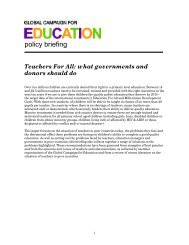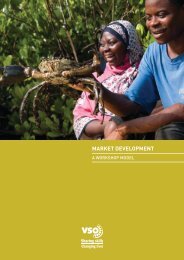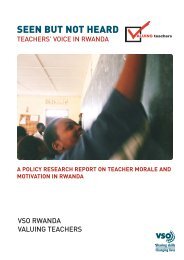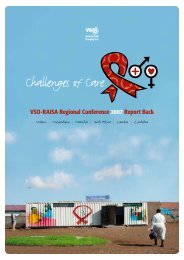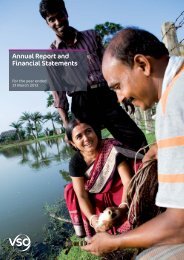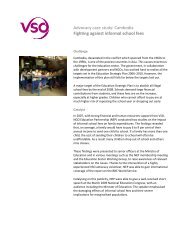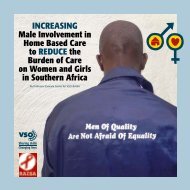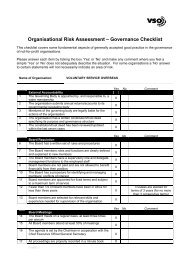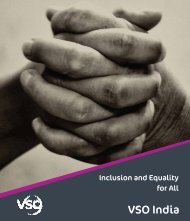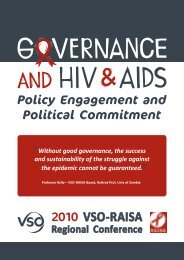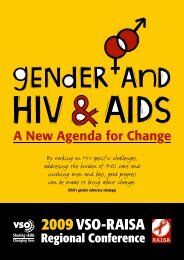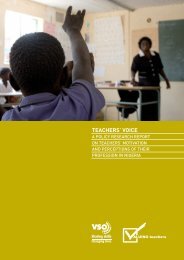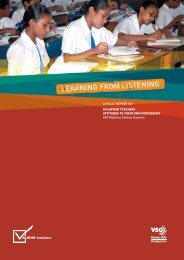Walking the Talk - VSO
Walking the Talk - VSO
Walking the Talk - VSO
You also want an ePaper? Increase the reach of your titles
YUMPU automatically turns print PDFs into web optimized ePapers that Google loves.
and testing. A few of <strong>the</strong> strategies, such as prevention ofmo<strong>the</strong>r-to-child transmission plus, can be consideredcross-cutting, as <strong>the</strong>y involve elements of all of <strong>the</strong>sestrategies. No strategy will succeed if tackling genderinequality and women’s lack of power to use HIVprevention is not at its heart.3.1. Women’s right to education and informationSexuality education in schoolsIn <strong>the</strong> absence of a cure for HIV and AIDS, educationhas been called a ‘social vaccine’ for preventing HIV.Research in a variety of settings asserts that educatedgirls are more likely to know <strong>the</strong> basic facts about HIVand AIDS, more empowered to negotiate safe sex, maybe more likely to delay sexual activity, and are less likelyto suffer from sexual and gender-based violence. 57Women with at least a primary education are threetimes more likely than uneducated women to know thatHIV can be transmitted from mo<strong>the</strong>r to child. 58Schools play a crucial role in providing vital informationon HIV prevention. They are often <strong>the</strong> only method fordelivering information on HIV prevention, especially inremote places, or where access to family planninginformation only exists for married couples, such as inVanuatu. Recent statistics make it clear that youngpeople need better access to accurate information onsafer sex. According to UNAIDS, “though <strong>the</strong>Declaration of Commitment on HIV/AIDS aimed for 90%of young people to be knowledgeable about HIV by2005, surveys indicate that fewer than 50% of youngpeople achieved comprehensive knowledge levels.” 59 InZimbabwe, adolescents associated with this study“showed ignorance of sexual and reproductive rights”as well as negative perceptions about condoms which<strong>the</strong>y associate with lack of trust among partners. 60 InVanuatu, girls openly said that <strong>the</strong>y were afraid to ask touse condoms “in case <strong>the</strong>y were accused of beingpromiscuous” and showed a clear lack of knowledgeand familiarity with <strong>the</strong>ir bodies when acknowledging<strong>the</strong>ir anxiety to use condoms for fear that “<strong>the</strong>y wouldget stuck”. 61Education also plays a second, crucial role in“empowering young women to take control of <strong>the</strong>irsexual lives.” 62 Studies have shown, for example, that“completion of secondary education was related tolower HIV risk, more condom use and fewer sexualpartners, compared to completion of primaryeducation”. 63 We also know young people are morelikely to delay sexual activity if <strong>the</strong>y receive correct andunbiased information, allowing <strong>the</strong>m to make informeddecisions. 64 For example, highly educated girls andwomen are better able to negotiate safer sex, having animpact on HIV rates. 65 Given <strong>the</strong> predominance ofpressure to enter into high-risk sex, this is especiallyimportant. In research completed in Nigeria, SouthAfrica and Vanuatu, boys were generally quoted aswanting to have ‘skin to skin’ sex. 66 In South Africa, forexample, HIV prevention strategies involving life-skillsprogrammes focusing on HIV and AIDS in schools werefound to be “not appropriate for women who are poorand vulnerable to violence” because <strong>the</strong>y do not “digdeep into <strong>the</strong> dynamics of gender inequality and armyoung women and men to transform <strong>the</strong> cycle ofinequality and gender-based violence in society.” 67Taught properly, sexuality education can begin tochange harmful gender stereotypes and empower boysand girls to make choices about healthy sexualbehaviours, including protecting <strong>the</strong>mselves from HIV.Information given must be comprehensive and evidencebased, and lessons must go beyond presentingbiological facts to providing a space for girls and boysto discuss, challenge and analyse gender relations. Thisshould include gender equality, girls’ empowerment,mutual respect, gender-awareness education for boysand girls, and empowerment training for girls.Information should be fully integrated in school curriculain consultation with <strong>the</strong> community, local leaders andgatekeepers. An example of good practice is <strong>the</strong> newcurriculum developed last year in Nigeria forcomprehensive sex education targeting 10-18 year olds.It aims to increase <strong>the</strong>ir knowledge and change <strong>the</strong>irattitudes to sexual health and reduce risky behaviours.In <strong>the</strong> past such measures would have faced strongopposition on religious and cultural grounds, but thistime <strong>the</strong> curriculum was developed in consultation withreligious and community leaders, showing promisingsigns for long-term implementation. 68To enable effective sexuality education, governmentsmust invest in girls’ education to send <strong>the</strong> strong signalthat <strong>the</strong>ir education is just as important as that of boys.Although, worldwide, girls’ enrolment has gone up,gender inequality in accessing education remains animportant issue, 69 in particular in sub-Saharan Africa. 70The efforts must be sustained at all levels of educationsince gender inequality in accessing secondaryeducation stems from disparities in primary education. 71In Vanuatu, as in many countries surveyed, “boys in <strong>the</strong>family get priority if resources are limited.” Educatinggirls was seen as a “waste of resources if you just wan<strong>the</strong>r to stay home,” since “educating women mightencourage <strong>the</strong>m to look outside <strong>the</strong> home”. 73 Thisshows that family and marriage are still often wrongly<strong>Walking</strong> <strong>the</strong> talk putting women's rights at <strong>the</strong> heart of <strong>the</strong> HIV and AIDS response 21



